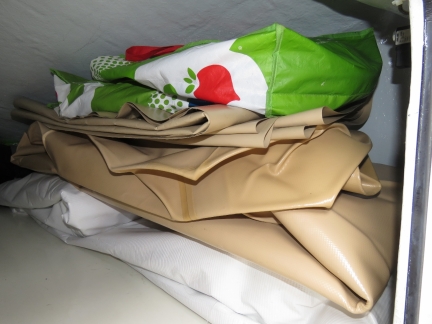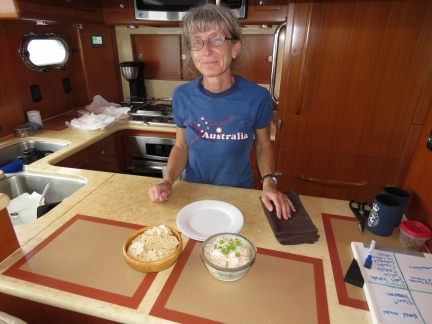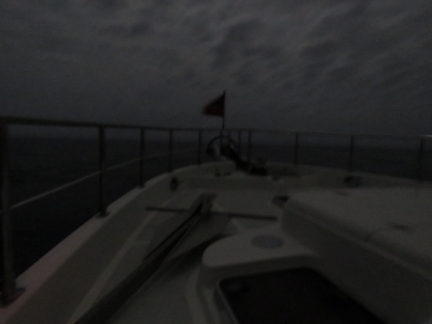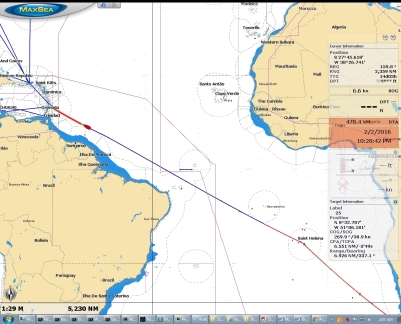By January 31st, we’d covered another 1,500 miles on our 3,650-mile journey from St. Helena to Barbados and had been at sea for three weeks. A lot happened in this portion of the trip. We crossed the equator and returned to the northern hemisphere after nearly three years away, and passed the halfway mark on this passage. We did our first oil change at sea, and shut the main engine down for the first time ever on a passage. We ended up shutting it down again on this trip to change a stabilizer actuator. Overall the oil change went extremely well. We were particularily impressed with the Lugger wing engine—it ran like a champ. It’s the first time we have run on the wing engine at sea rather than in test.
We also transferred all our deck fuel to the main tanks below decks and stowed our bladders. And we returned to the coverage area of of our KVH mini-VSAT satellite data system, with a several-day hiatus as we passed through the equatorial dead zone nearly directly below the satellite.
Conditions remained excellent until we were a couple of days across the equator, then we got into the northeast trade winds with 15-20 knot winds and tight 7-8ft seas on 7 seconds. As the month ended, we were within 500 miles of Barbados and all systems were running smoothly.
Trip highlights from January 19th through 31st follow. Click any image for a larger view, or click the position to view the location on a map. And a live map of our current route and most recent log entries always is available at http://mvdirona.com/maps
 |
Speed
Position: -28 16.38, -4 14.25
Our speed has been steadily above 6 kts at 1.5-1.6nm/g for the past day. Possibly we are getting into the South Equatorial Current that flows northwest along the northeast coast of South America. Sea conditions remain excellent with light winds. In the next couple of days, we still expect the wave period to begin to tighten from 10 to 7-8 seconds, and the wave height increase from 5ft to 7-8ft. This will coincide with a shift in wind and wave direction from SE to NE as we get into the NE trade winds.
|
 |
Birds
Position: -28 41.00, -4 0.42
Now that we’re running closer to shore, we’re starting to see a lot more birds. Now if we can just get them to stop overnighting on the boat deck and burying it in bird guano, it would be ideal.
|
 |
Storms
Position: -28 59.43, -3 50.01
Several rainstorms rolled through this morning. It’s the first significant rainstorm since before Cape Town.
|
 |
Conditions
Position: -29 50.95, -3 20.87
The winds picked up to NE 20-25 today and the waves tightened, increasing max roll and pitch to a still-mild 10 and 9 degrees respectively. We thought that we were getting into the NE trades a little earlier than expected and that was the end of our calm conditions. But the winds settled back down to 10-15 and max roll and pitch over the past hour are back down to 6.6 and 4.4 degrees and have remained that way since. The wind spike and pitch spikes are particularly obvious on the 2nd row of the display, while roll increased and decreased more gradually.
|
 |
2,000nm
Position: -30 14.78, -3 7.40
We’re still not halfway yet, but have only 2,000nm left to go. We remember leaving San Francisco for Hawaii on our first ocean crossing, a 2,000-mile trip. It seemed huge at the start and now 2,000 miles feels like we’re close to done.
|
 |
Oil change
Position: -31 9.79, -2 37.20
This morning we slowed the boat down and transferred over to wing propulsion, moved the stabilizers over to wing power, and tried to find the calmest direction to run the boat. That was the little loop you can see in our track. Then we shut down the main engine and changed the main engine oil and filter. It took about 10 to 15 min and, once everything was back to normal and we were all cleaned up, we moved back to our original course. Read more …
|
 |
Draining the bladders
Position: -31 18.38, -2 31.39
We’ve got enough space in the main tanks that we can drain the two 300-gallon cockpit bladders now. Here the port bladder is still full and we have almost emptied the starboard bladder. The drain hose runs from the valve at the left of the photo to the cockpit bulkhead fitting at the upper right. See Fuel for the Crossing for details of our fuel transfer process.
|
 |
Ships
Position: -32 10.12, -2 2.00
Around 1am we passed two boats about 6 miles to port and could see a bright white light from one of them. Judging by their random speed and direction, both likely were fishing vessels. We also picked up an AIS target much further away that passed a good 20 miles behind us. It never got close enough for us to pick up any AIS detail.
|
 |
Sink
Position: -32 50.32, -1 39.12
Spitfire is always adjusting his sleeping location. Here he is back in an old favourite: the master head sink. He frequently sleeps here in heavy weather. When conditions were consistently rough on our passage to the Marquesas, he pretty much lived there.
|
 |
Bladders empty
Position: -32 50.78, -1 38.86
We finished draining the bladders last night. All fuel now is below decks and our main tanks are close to full again.
|
 |
Halfway
Position: -32 53.28, -1 37.43
We just passed the halfway mark of 1825 miles. It’s all downhill from here.
|
 |
Power wash
Position: -33 20.73, -1 21.81
We moved the boat deck table out of the way and brought the cockpit bladders up to power wash them clean before stowing them.
|
 |
Cleaned and folded
Position: -33 25.57, -1 19.05
One cockpit bladder, cleaned and folded and ready to stow. The cockpit bladders have white protective covers that we leave on when stowing to minimize sharp creases and also to protect the bladders from anything that might rub against them.
|
 |
Bladders stowed
Position: -33 27.97, -1 17.69
All three fuel bladders stowed in the flybridge brow. The two cockpit bladders are at the bottom and the forward bladder is on top. Above the bladders are thin plastic base pads for each bladder. At the very top, in the green Amazon Fresh bags, are the fuel transfer hoses.
|
 |
Salmon dip
Position: -33 35.13, -1 13.62
Smoked salmon dip for lunch, made with fresh spring onions from Cape Town.
|
 |
Equatorial dead zone
Position: -33 43.15, -1 9.06
We’ve just hit the equatorial dead zone for our KVH mini-VSAT satellite data system. Our antenna, a KVH V7, cannot look skyward higher than 80 degrees. The only satellite in view from here is very near at 37W and, like all geosynchronous satellites, it flies directly over the equator. We are at 34W and also near the equator. Because the satellite is very nearly directly above us, we can’t contact it. Using the official estimate of the no-coverage zone, we will be out again in 4 days. We think it might actually be a bit earlier if the boat motion isn’t too much. For now we’re back on BGAN :(.
|
 |
Breaker panel
Position: -35 20.38, 0 13.64
Our pilothouse breaker panel is behind two plexiglass doors. The doors bend and flex in the heat, and one broke off today. We decided to just remove both and it both looks better and is much easier to access. We should have done that years ago.
|
 |
Hot
Position: -35 35.91, 0 4.78
The boat deck is so hot from the sun we could hardly stand on it. A heat gun showed it at 136.6°F.
|
 |
Equator
Position: -35 44.30, 0 0.00
We just crossed the equator and have returned back to the northern hemisphere after nearly three years away. This equator-crossing has been so much more comfortable than the north-to-south crossing, partly because conditions have been incredibly calm, but also because we can run the air conditioning 24×7 off the 240V inverter. We were really battling the heat on that passage to the Marquesas.
|
 |
Caribbean timezone
Position: -35 46.41, 0 1.20
We’ve changed the clocks back again and now are on Caribbean time. We’re enjoying our passage, but definitely will be ready for a little “island time” when we get in.
|
 |
PG-500
Position: -35 49.73, 0 3.06
James adjusting the autopilot compass heading to match the SC30’s heading. This allows us a smoother transition to the satellite compass if the SC-30 loses heading. The SC-30 lost heading glitch is interesting. We initially thought it was a combined weather station and satellite compass problem, as wind data and heading went away at the same time. Both instruments are mounted at the top of the stack and connect to the NMEA 2000 bus through the same cabling, so this seemed plausible. But we later realized that we are displaying true wind direction, and heading is required to calculate that, so it’s only the sat compass is at fault. The sat compass heading sensor is essentially two GPS receivers, where the location of each shows the direction. When one GPS fails, it’ll have GPS but no heading, so possibly one of the GPSs is failing. Another possibility is that we once saw a case where legal data on the NMEA 2000 bus caused the sat compass problems and it went off line. At the time it was a Maretron ACM100 (alternating current monitor) sending data every 100 msec. We changed it to 1,000 msec and the sat compass was back to normal–an easy workaround. We’re pretty sure there was nothing illegal in what the ACM100 was sending, but for some reason it causes the SC-30 problems when it was sent frequently. For the current lost heading issue, we found a protocol violation in something we were doing that’s been there for years, so it is unlikely to be the cause of the problem. However the sat compass has worked without error for the past 36 hours. If it goes for something close to a week, we’ll think we have it. At this point, we still suspect an internal problem in the sat compass but time will tell.
|
 |
Celebration
Position: -35 59.63, 0 8.75
A glass of sparkling cider to celebrate crossing the equator and passing the halfway mark on our 3,650nm passage.
|
 |
Sunset
Position: -36 4.15, 0 11.32
Our first northern hemisphere sunset in nearly three years. Because we set the clocks back two hours to Barbados time, sunset was about 4:30, so we watched it from the flybridge before dinner.
|
 |
Moonlight
Position: -36 35.93, 0 29.44
We’re humming along at just over 6 knots with a bright moon lighting the foredeck. Conditions remain excellent, with the winds E-to-NE 10-15 knots and waves about 5ft on 7-8 seconds. We expect this to last about 2-3 more days and then we’ll have 15-20 kt winds and 8 ft waves on 7 seconds, all from the NE, for most of the rest of the run as we get into the NE trade winds.
|
 |
Hitckhiker
Position: -37 27.91, 0 59.06
A small crab has hitched a ride for the past few days, but disappeared soon after the bladders were stowed. We found a dead fish under one of the bladder covers, so perhaps it was eating that and once the food went way it abandoned ship.
|
 |
Looking back
Position: -37 44.60, 1 8.56
Jennifer enjoying the view from the cockpit. It’s great to have the bladders stowed and our cockpit back looking like normal again.
|
 |
Water temperature
Position: -37 50.06, 1 11.66
Even though we have two temperature sensors that both were reading 100°F, we had become suspcious of that number. So we dipped some saltwater off the back deck and measured the temperature using two different galley thermometers. Both read approximatly 85°F as did a heat gun measurement of the hull where one of the sensors is mounted. This is disappointing as it appears the water temperature has been wrong for a long time, perhaps upwards of a year. It’s a reminder to all of us to not trust any sensor, chart, or instrument without verification. And, even with that verification, there is a tiny chance of it still being off. In this case the Maretron sensor which is the one we use and record, is reading 15°F high. The Furuno sensor shows 101F on the Furuno MFDBB display, but the NMEA 2000 PGN that it is sending is correct at 85F. So we appear to have a faulty instrument on the Maretron side and some sort of display bug in the Furuno MFDBB. We problably should change the Maretron sensor but for now, we put 15F of bias in it and will now use it as a backup sensor and switch over to using the Furuno sensor. We’ll also setup an alert to flag whenever they differ.
|
 |
Own dynamic data
Position: -37 56.08, 1 14.66
We had a few faults in the SC-30 satellite compass a couple of weeks back. They’re now fixed and it’s running like a champ. But we would like it to be the case that if the SC30- does fail, there’s a lot less drama. Our backup is a Maretron GPS200 for position and SSC200 for heading. What we’ve done today is to make sure we can unplug the SC-30 and everything continues to operate without problem. Pictured is our AIS data that is sent to other ships–we’re sending course, speed and position correctly with the SC-30 unplugged.
|
 |
Ship
Position: -38 57.15, 1 49.90
A large ship passed about 3 miles to our north around midnight. We could see it’s deck lighs in the distance, but it was not transmitting AIS information.
|
 |
Conditions
Position: -39 5.22, 1 54.50
As expected, the wind picked up to NE 20-30 earler today and the waves tightened to about 7-8ft on 7-8 seconds. Max roll and pitch over the past hour was 12.7° and 11.2° respectively. (The screenshot shows this data graphically for the past 24 hours in the third row). We’ve learned from experience that Jennifer will get seasick if we pitch steadliy over 10°, so she’s wearing a scopolamine patch now. As the waves picked up, our speed fell and we were doing less than 5 knots to meet the fuel economy goal. So we reduced our fuel reserve from 400 to 300 gallons to allow us to run a little faster. This bought us a half to a full knot increase in speed.
|
 |
Actuator
Position: -39 47.29, 2 15.22
Stabilizer actuators are wear items that ABT recommends replacing every 2,000 hours. This one failed in 1,000 hours, which is way too early. They should be able to go upwards of 3,000 hours. This is the failed actuator. Because it lasted roughly half of its expected lifetime, we’re investigating possibly alignment issues, but haven’t found any issues yet. Read more …
|
 |
Orange Ocean
Position: -41 56.93, 3 31.79
The unusually all-white 558ft Orange Ocean passed about five miles away heading to Newark.
|
 |
Front Circassia
Position: -42 59.43, 4 7.02
The Front Circassia passed about 12 miles to our north just before midnight, but was too far away to see the navigation lights. The 1,098ft tanker was heading to Rio de Janeiro.
|
 |
Kikyo
Position: -43 6.75, 4 11.14
The 738ft tanker Kikyo en route to Singapore passed about 5 miles away. Commercial traffic definaiely is picking up.
|
 |
7.7 kts
Position: -43 8.80, 4 12.29
We’re making unexepectedly good speed of 7.7 kts despite the conditions. We must be picking up a knot or so from the South Equatorial current.
|
 |
Conditions
Position: -43 38.38, 4 28.88
We’re in tight 9ft seas on 7 seconds and boat motion is pretty substantial. We’re rolling steadily 20 degrees and just had one roll to 31.5°. The seas are so short and sharp that it’s suprisingly difficult to move around in the boat and it’s actually a bit unpleasant.
|
 |
1,000 miles
Position: -44 29.50, 4 57.54
We’re now within 1,000 miles of the Barbados coast.
|
 |
Bomar Resilient
Position: -45 3.28, 5 16.47
The 689ft Bomar Resilient passed about two miles to our south carrying dangerous cargo bound for the port of Coega at Port Elizabeth, South Afrcia.
|
 |
High pressure system
Position: -45 27.77, 5 29.95
The rough seas we’ve been experiencing are partly due to our passing through the southern edge of a massive high pressure system that stretches across much of the northern Atlantic. We expect conditions to improve slightly in a day or so.
|
 |
Slow
Position: -46 38.36, 6 9.15
We’ve hit an unexepcted negative current and have had to drop below 5 knots to maintain our fuel economy goal. The good news is that the seas are starting to settle down a bit. Maximum roll and pitch for the past hour have been 15.9 and 8.3 degrees respectively, down from 31.5 and 10.4 yesterday morning.
|
 |
7,502 hours
Position: -47 4.88, 6 23.87
We just crossed 7,500 trouble-free hours on our John Deere main engine. The hours sure are winding on quickly–we left Darwin 5 months ago with only 5775 engine hours.
|
 |
Bring out your dead
Position: -48 6.32, 6 57.84
Every morning James does a “bring out your dead” pass around the boat, throwing dead fish back into the ocean.
|
 |
Sleeping
Position: -48 16.50, 7 3.42
When conditions get rough, sleeping in the berth is difficult and sometimes even dangerous. We slide around too much on the berth and it keeps us awake, and James was once thrown off the berth in a particularly large roll. So when it’s rough we sleep on the floor. Jennifer wedges into the walkway to port of the berth (pictured), and James sleeps on the opposite side on his off-watch shift. We sleep remarkably well this way, hardly waking up at all. Spitfire particularly likes Jennifer’s side–he makes a little spot for himself at her feet and sleeps for ages.
|
 |
Woohoo!!!
Position: -48 22.05, 7 6.44
After showing several different error messages and multiple reboots, our always-on KVH mini-VSAT satellite data system finally hooked up last night. We were well out of the equatorial dead zone when it did connect, so we anticipate there is some hardware issue.
|
 |
Slow
Position: -49 1.08, 7 27.68
We continue to battle an unexpected negative current. Here we’re doing only 3.5 knots and the “drive to the lights” indicator at the bottom center of the display says we must slow down even further to meet our fuel economy goal.
|
 |
Course change
Position: -49 23.10, 7 39.65
Predicting how many days we have left is getting harder. Several times we have hit absolute brick wall currents. At one point we were slowed down to below 4 kts. We decided to allocate 100 gallons from the reserve to go a bit faster. We declared “success” on fuel a week ago and yet this morning we were back to talking about it and thinking that this current could actually make a massive safety margin look close if it continues unabated. We moved inland a bit looking for more favorable currents and are perhaps doing a bit better but we are running in the high 4 kts when we should be running in the 6 kts range. Overall, we are great on fuel but it’s amazing what a major effect good or bad currents can have. It’s one of the reasons it’s hard to really know a boat’s range — real world range changes so dramatically with environmental conditions.
|
 |
Conditions
Position: -51 32.83, 8 40.82
We finally escaped the counter-current and now are making reasonable speed of over 6 kts again. We’re still in 7-8ft seas on about 7 seconds with consistent rolls about 10° and the max roll over the past hour at 16.4°. Pitch has reduced slightly to under 10°. We expect these conditions for the rest of the way to Barbados.
|
 |
Dolphins
Position: -52 7.81, 8 58.10
A big pod of dolphins put on a great show, leaping and twisting off our bow.
|
 |
Below 500 nm
Position: -52 18.98, 9 3.61
We’ve covered 3,172 nautical miles now, and have only 478 to go. We’re getting close!
|
 |
Speed
Position: -52 28.22, 9 8.16
Yesterday morning we were barely making 5 knots. This morning, with help from a positive current, we are averaging nearly 7 knots now while meeting our fuel economy goal.
|

|
Click the travel log icon on the left to see these locations on a map, with the complete log of our cruise.
On the map page, clicking on a camera or text icon will display a picture and/or log entry for that location, and clicking on the smaller icons along the route will display latitude, longitude and other navigation data for that location. And a live map of our current route and most recent log entries always is available at http://mvdirona.com/maps. |
If your comment doesn't show up right away, send us email and we'll dredge it out of the spam filter.

Really glad to know everything went okay with the oil change and shutting down the main engine James. I know that had be of great concern. Happy to know you and Jennifer arrived safely and are enjoying the Caribbean sunsets!
Yes, the oil change went without issue. In fact, it went so well, that we subsequently shut down again to replace a leaking hydraulic actuator which was unexpected but the service went well.
Dinner and the Superbowl last night on the sand at Surfside resteraunt and, yes, there was a great sunset just before the game started. Hard to beat.
Congratulations on completing this long, (record breaking?) voyage. Given you earlier comments on days at sea, may I conclude that this latest voyage will get ticks in the columns headed Been there! Done That! and Never to be Repeated! ?
David asked if this was a never to be repeated trip. It was a long one for sure but it wasn’t difficult. Having done it, we now have really long distance runs as another tool we can use with comfort. As long as the weather isn’t difficult or dangerous, long trips really aren’t bad at all.
We do have to admit that we are ready to slow down for a bit :-). We have covered a lot of water since Australia.